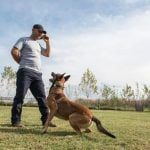Search and rescue (SAR) dogs play a critical role in locating missing persons, providing essential assistance during disaster response efforts, and saving lives. These highly trained canines possess unique skills and instincts that enable them to navigate difficult terrain, detect human scent, and effectively work with their human handlers to carry out successful search and rescue operations.
But how exactly are these remarkable dogs trained? In this article, we will delve into the world of SAR dog training and explore the various methods, techniques, and considerations involved in preparing these extraordinary animals for the invaluable work they perform.
Training a SAR dog encompasses a comprehensive process that involves developing specific qualities and traits suited for search and rescue missions. We will examine the key attributes that make an effective SAR dog, including intelligence, agility, drive, determination, and resilience. Additionally, we will discuss the importance of choosing the right breed for SAR training based on their inherent characteristics and abilities.
Basic obedience training serves as the foundation for SAR training. It is essential to establish strong communication between the dog and handler through commands such as sit, stay, come, and heel.
With a solid obedience foundation in place, specialized training techniques can be implemented to teach a range of necessary skills required for search and rescue operations. From scent discrimination and tracking abilities to endurance building exercises and physical fitness routines, SAR dogs undergo rigorous training programs designed to hone their natural abilities.
As we dive deeper into this article on how to train a dog for search and rescue missions, we will explore advanced training methods that enhance the capabilities of these remarkable animals. We will also investigate how involving human handlers in the training process leads to effective coordination between humans and dogs during actual search operations.
Through real-life scenarios and simulated exercises, SAR dogs gradually develop expertise in locating missing individuals in challenging environments such as collapsed buildings or dense forests. Continuous training sessions ensure that these extraordinary dogs maintain their skills over time while evaluations assess their proficiency level.
Understanding the Qualities and Traits of an Effective SAR Dog
Search and rescue (SAR) dogs play a crucial role in locating missing persons and saving lives. These four-legged heroes possess certain qualities and traits that make them effective in their search and rescue tasks. Understanding these key qualities is essential in selecting and training the right candidates for SAR work.
One of the most important qualities of an effective SAR dog is their strong drive to search. These dogs have a natural instinct to locate scents, which makes them highly motivated and focused on finding people. They are persistent and will not easily give up until they locate the target individual.
Another essential trait of a successful SAR dog is their ability to work independently without constant supervision. In search and rescue operations, these dogs often work off-leash and must be able to make decisions on their own. They must have the confidence to navigate through challenging terrain, changing weather conditions, and other obstacles.
Additionally, SAR dogs need to possess excellent scent detection skills. Their sense of smell is much more powerful than that of humans, allowing them to pick up on even the faintest odor. They can differentiate between different scents even in confusing or heavily contaminated environments, making them reliable in detecting human scent amidst various distractions.
To summarize, an effective SAR dog should have a strong drive to search, be capable of independent decision-making, and possess exceptional scent detection abilities. Understanding these qualities is crucial when choosing breeds for SAR training as not all dogs are suitable for this demanding line of work.
| Qualities | Traits |
|---|---|
| Strong drive to search | Motivated, persistent |
| Ability to work independently | Confident decision-making |
| Scent detection skills | Powerful sense of smell, can differentiate scents |
Choosing the Right Breed for Search and Rescue Training
Choosing the right breed for search and rescue (SAR) training is crucial to ensure the success and effectiveness of a SAR dog. Not all breeds are suitable for this type of work, as certain traits and characteristics are necessary for SAR dogs to excel in their tasks.
Qualities Required in SAR Dogs
Firstly, SAR dogs need to have a strong drive to work and possess great determination. They should exhibit resilience, adaptability, and the ability to work under stressful conditions. SAR dogs must also possess high energy levels, as they are often required to cover large areas and engage in physically demanding tasks.
Breeds Most Suited for SAR Work
There are several breeds that are known to excel in search and rescue work due to their natural abilities. The German Shepherd Dog is one of the most popular choices due to its intelligence, agility, loyalty, and strong work drive. Labrador Retrievers are also commonly used due to their exceptional scenting abilities and versatility.
Other breeds that are frequently chosen for SAR training include Belgian Malinois, Border Collies, Golden Retrievers, and Bloodhounds. Each breed brings unique qualities that make them well-suited for specific aspects of search and rescue work.
Considerations for Individual Dogs
While certain breeds may be generally well-suited for SAR training, it is important to consider the individual dog’s temperament, health condition, and physical capabilities. Working with a reputable breeder or rescue organization can help in selecting a dog that meets the specific requirements of search and rescue work.
It is important to note that mixed-breed dogs can also be successful in SAR training if they possess the necessary qualities and physical abilities. Ultimately, it is crucial to assess each dog on an individual basis rather than solely relying on breed stereotypes when choosing a SAR canine partner.
Basic Obedience Training as a Foundation for SAR Training
Basic obedience training is a crucial foundation for search and rescue (SAR) dog training. This training establishes the groundwork for all future training and ensures that the dog has the necessary skills and discipline to succeed in SAR work. In this section, we will explore the importance of basic obedience training and some key techniques to consider.
The Importance of Basic Obedience Training
Before diving into more specialized SAR training, it is essential to establish a strong obedience foundation with your dog. Basic obedience commands such as sit, stay, come, and heel are not only vital for a well-behaved pet but are also crucial in SAR scenarios where the dog must follow instructions quickly and reliably.
Basic obedience training helps develop focus, impulse control, and reliability in your SAR dog. It teaches them to listen to their handler’s commands amidst distractions and high-stress situations. Additionally, it establishes clear communication between the handler and the dog, making it easier to convey instructions during search and rescue missions.
Techniques for Basic Obedience Training
Positive reinforcement methods using rewards like treats or verbal praise are highly effective in basic obedience training for SAR dogs. Start with simple commands like sit and reward your dog when they perform the desired behavior correctly. Gradually increase difficulty by incorporating distractions or adding more advanced commands.
Consistency is key in basic obedience training. Use the same verbal cues for each command consistently so that your dog becomes familiar with them. Practice regularly in different locations to generalize their understanding of commands across various environments. Keep sessions short and fun, ending on a positive note to keep your dog engaged and motivated.
Specialized Training Techniques for Search and Rescue Dogs
Once a search and rescue (SAR) dog has mastered basic obedience training, they can move on to specialized training techniques that are essential for their role in locating missing persons. These techniques are designed to enhance their natural abilities and improve their effectiveness in various search scenarios.
One such technique is scent detection training. SAR dogs rely heavily on their sense of smell to locate missing individuals, and it is crucial for them to be able to discriminate between the desired scent and other distractions. They are trained to recognize specific scents associated with humans, such as sweat, skin cells, or clothing articles. Through repetitive exposure and rewards-based training methods, SAR dogs learn to identify and track human scents over long distances.
Another important skill that SAR dogs develop is rubble search training. This type of training prepares them for situations where there may be collapsed structures or debris in search areas, such as after earthquakes or building collapses. Dogs are taught how to navigate through the rubble while using their sense of smell to locate live human beings trapped underneath. This type of training requires the use of specialized equipment like harnesses and boots to protect the dog’s paws.
| Training Technique | Description |
|---|---|
| Scent Detection Training | Involves teaching the SAR dog to recognize specific human scents associated with missing persons. |
| Rubble Search Training | Prepares the dog to navigate through collapsed structures or debris in order to locate live human beings. |
In addition, tracking training is vital for SAR dogs as it allows them to follow a specific scent trail left by a missing person. By teaching dogs to follow footprints, disturbances in the vegetation, or other scent markers left by the individual, they can successfully track and find the person they are looking for. This training requires a lot of patience and practice to ensure that SAR dogs can effectively follow complex scent trails in various terrains and environments.
Overall, specialized training techniques play a crucial role in transforming a well-trained dog into an effective search and rescue asset. Through scent detection, rubble search, and tracking training, SAR dogs become skilled at locating missing persons in different scenarios. It is important for trainers to customize these techniques based on the needs of their specific search and rescue organization and the breed characteristics of their canine partners.
Developing Scent Discrimination and Tracking Skills
Developing scent discrimination and tracking skills is crucial for search and rescue (SAR) dogs as it allows them to locate missing individuals in a variety of environments. This skill involves teaching the dog the ability to differentiate between the specific scent of a target individual from other scents present in the area. Here are some key considerations and training techniques for developing scent discrimination and tracking skills in SAR dogs.
The Importance of Scent Discrimination
In order to effectively track and locate missing individuals, SAR dogs must be able to discriminate between different scents. This means that they need to be able to identify and follow the scent trail of the specific person they are searching for, while ignoring other distractions or scents that may be present. Scent discrimination is what sets SAR dogs apart from other working dogs, as it allows them to locate individuals who may be hidden or trapped in challenging situations.
Training Techniques for Scent Discrimination
One effective method for developing scent discrimination skills in SAR dogs is through progressive scent training. This involves gradually introducing the dog to different scents and teaching them to recognize and follow the specific scent of their target individual. The process starts with imprinting where a specific individual’s scent is introduced to the dog through items such as clothing or personal belongings.
Once the dog has become familiar with the target individual’s scent, they can progress to more advanced tracking exercises. These exercises involve setting up simulated search scenarios where the dog follows a trail laid by the target individual and rewards are provided at various intervals along the trail. Over time, the difficulty of these exercises can be increased by introducing distractions or making the trails more complex.
Building on Tracking Skills
Tracking skills go hand in hand with scent discrimination when it comes to search and rescue work. Teaching a dog to track involves training them to follow a ground disturbance left by an individual’s passage, such as footprints or disturbed vegetation. The dog uses their sense of smell to interpret these clues and follow the trail left by the target individual.
Training a dog to track effectively requires consistent practice and reinforcement. This can be done through frequent tracking exercises in various terrains and weather conditions. By gradually increasing the difficulty of the exercises, such as adding age to the scent trail or introducing obstacles for the dog to overcome, their tracking skills can be fine-tuned and improved over time.
By honing their scent discrimination and tracking skills, search and rescue dogs become invaluable assets in locating missing individuals. These training techniques help create highly skilled SAR dogs that are capable of navigating complex environments and efficiently finding those in need of assistance.
Building Endurance and Physical Fitness for SAR Dogs
One of the most crucial aspects of training a search and rescue (SAR) dog is building their endurance and physical fitness. SAR dogs are expected to work long hours in various terrains and weather conditions, requiring them to be in top physical condition. This section will discuss the importance of building endurance and physical fitness for SAR dogs, as well as some effective training techniques.
Endurance is essential for SAR dogs as they may need to search vast areas for an extended period until they find the missing person or locate the target scent. A physically fit dog will be able to sustain their energy levels throughout demanding search missions, enabling them to cover more ground efficiently. Moreover, a well-conditioned dog is less likely to get injured or exhausted during SAR operations.
To build endurance and physical fitness in SAR dogs, regular exercise is key. Long walks or hikes on varied terrains can help improve cardiovascular health and stamina. Incorporating activities like swimming and agility exercises can also enhance a dog’s overall strength, flexibility, and coordination.
In addition to regular exercise, mental stimulation is equally important in improving a SAR dog’s endurance. Engaging them in puzzle-solving tasks, scent detection games, and obedience drills not only tires them mentally but also hones their focus and concentration skills. Mental fatigue should also be taken into account during training sessions, as it can impact a dog’s performance and overall endurance.
Overall, building endurance and physical fitness should be a priority when training a search and rescue dog. Regular exercise combined with mental stimulation can significantly contribute to enhancing their performance in real-life search operations.
| Endurance-building Tips | Physical Fitness Training |
|---|---|
| Regular long walks or hikes on varied terrains | Swimming exercises |
| Mental stimulation through puzzle-solving tasks | Agility exercises |
| Scent detection games for focus and concentration | Obedience drills for coordination |
Advanced Training Methods for Search and Rescue Canines
Once a search and rescue (SAR) dog has mastered basic obedience and specialized training techniques, it is important to introduce advanced training methods to enhance their skills and effectiveness in real-life scenarios. These advanced methods focus on refining the dog’s abilities in various aspects of SAR work, including agility, remote signaling, and problem-solving. Here are some key advanced training methods used for search and rescue canines:
- Agility Training: SAR dogs often encounter difficult terrain or obstacles in their search missions. Agility training helps prepare them to navigate these challenging environments by improving their balance, coordination, and flexibility. This can involve exercises such as obstacle courses with ramps, tunnels, A-frames, and weave poles.
- Remote Signaling: In some instances, SAR dogs need to signal for help or communicate with their handlers from a distance. Remote signaling training teaches dogs how to use various devices such as bells, whistles, or buttons to call attention to their location. Dogs learn to press a button with their nose or mouth or ring a bell when they find someone in need of assistance.
- Problem-Solving Exercises: In complex search operations that require critical thinking skills, search and rescue canines must be trained to think independently and make decisions based on the situation at hand. Problem-solving exercises involve presenting the dog with different scenarios that require them to adapt their searching strategies accordingly.
Using these advanced training methods not only enhances the capabilities of SAR dogs but also helps build their confidence and adaptability in challenging situations. By continually challenging them with new tasks and scenarios, handlers can ensure that the canines stay engaged and fully prepared for any search mission they may encounter.
It is essential for handlers to work closely with experienced trainers who specialize in advanced SAR training methods. These trainers can provide valuable guidance and expertise to optimize the training process and help maximize the potential of search and rescue canines. Additionally, ongoing evaluations should be conducted to assess the effectiveness and progress of the dogs’ advanced training, allowing for adjustments or improvements as needed.
In the next section, we will explore how human handlers play a critical role in SAR dog training and coordination during search operations.
Involving Human Handlers in SAR Dog Training for Effective Coordination
In the world of search and rescue (SAR) dogs, effective coordination between the canine and their human handler is essential. This section will explore how involving human handlers in SAR dog training can enhance the effectiveness of search and rescue missions.
- Establishing a Strong Bond: The first step in involving human handlers in SAR dog training is to establish a strong bond between the handler and their canine partner. This bond is built through daily interaction, trust-building exercises, and positive reinforcement techniques. By creating a solid foundation of trust and communication, handlers can effectively lead their dogs during search and rescue operations.
- Communication and Command Training: Effective coordination requires clear communication between the handler and the SAR dog. Handlers must learn to give precise commands that convey their intentions to the dog. This includes using both verbal cues, such as commands like “search,” “stay,” or “track,” as well as non-verbal signals like hand gestures or body language cues.
- Navigation Skills: Human handlers must also possess strong navigation skills to lead their SAR dogs in the right direction during search operations. They need to be proficient in map reading, compass use, GPS navigation, and understanding topography. By relying on these skills, handlers can guide their dogs accurately towards areas of interest.
To facilitate effective coordination with human handlers, SAR organizations often provide specific training programs for them. These programs cover topics such as navigation techniques, communication strategies, understanding canine behavior cues, and emergency response protocols.
By involving human handlers in SAR dog training, search and rescue teams can optimize their efforts by working seamlessly together. The strong bond between handler and canine partner allows for effective leadership during missions, ensuring successful outcomes in locating missing individuals or providing aid in disaster situations.
Real-Life Scenarios and Simulated Exercises for SAR Training
One of the most crucial aspects of training a search and rescue (SAR) dog is exposing them to real-life scenarios and simulated exercises. This type of training helps prepare them for the unpredictable and often challenging conditions they may encounter in actual search and rescue missions. By providing opportunities for dogs to practice their skills in realistic settings, handlers can ensure that they are well-prepared to perform their life-saving duties.
One effective method of training is through realistic simulations of search and rescue scenarios. This can involve creating mock disaster sites or hiding objects for the dog to find in various environments, such as dense forests or collapsed buildings. By simulating the types of situations they may encounter in the field, dogs can gain valuable experience and develop their problem-solving abilities.
A key component of these simulations is providing distractions and obstacles that mimic the challenges they might face during a real search and rescue mission. For example, handlers may introduce loud noises, unfamiliar scents, or even other people and animals to simulate the chaotic environments that SAR dogs often work in. By exposing dogs to these distractions in a controlled setting, handlers can help desensitize them and ensure they maintain focus on their search tasks.
In addition to simulated exercises, SAR dogs also benefit from participating in real-life search and rescue missions whenever possible. These missions allow them to apply their training in authentic situations while working alongside their human handlers and other members of a search team. Real-life scenarios provide opportunities for reinforcement of learned behaviors, as well as an opportunity to assess areas that may need further training or improvement.
Overall, combining both real-life scenarios and simulated exercises provides a comprehensive approach to SAR dog training. These methods offer dogs exposure to the unpredictable nature of search and rescue work while allowing handlers to assess their strengths and weaknesses. With regular opportunities for practice in both simulated environments and actual missions, well-trained SAR dogs become invaluable assets when it comes to locating and saving missing persons in various situations and locations.
The Importance of Continuous Training and Evaluations for SAR Dogs
Continuous training and evaluations are crucial for search and rescue (SAR) dogs to maintain their skills and effectiveness in real-life situations. SAR work requires a high level of proficiency, as the dog’s ability to locate missing persons can be a matter of life or death. Training should be ongoing to keep the dogs sharp, reinforce their abilities, and introduce new techniques.
One reason why continuous training is important for SAR dogs is the need to reinforce key skills. Dogs can forget or become rusty if their training is not reinforced regularly. By periodically reviewing and practicing essential commands, scent detection techniques, and tracking abilities, SAR dogs will stay sharp and ready to respond to emergencies.
In addition, continuous training allows handlers to assess the progress of SAR dogs and identify areas that may require further development. Evaluations during training sessions provide an opportunity for handlers to observe how well their canine partners are performing under different circumstances. This allows them to make any necessary adjustments or modifications to the training program.
Moreover, continuous training helps prepare SAR dogs for new challenges they may encounter in real-life scenarios. Search and rescue work often involves unpredictable circumstances such as extreme weather conditions, difficult terrain, or unfamiliar environments. Regular training sessions can help familiarize dogs with these types of challenges and improve their ability to adapt and perform effectively in diverse situations.
Overall, continuous training and evaluations play a vital role in maintaining the skills and capabilities of search and rescue dogs. Through ongoing practice, reinforcement of essential skills, progress assessments, and exposure to new challenges, SAR dogs can continue making a life-saving impact in their crucial role as first responders in emergency situations.
Conclusion
In conclusion, well-trained search and rescue (SAR) dogs play a crucial role in saving lives in various emergency situations. These remarkable animals possess the unique qualities and traits that make them effective in locating missing persons, detecting scents, and navigating difficult terrains. Selecting the right breed is an important consideration, as certain breeds are better suited for SAR work due to their natural instincts and physical capabilities.
Basic obedience training serves as the foundation for SAR training, ensuring that dogs have a strong level of control and discipline before progressing to specialized techniques. Specialized training focuses on developing scent discrimination and tracking skills, allowing SAR dogs to locate specific individuals or items even in challenging environments. Building endurance and maintaining physical fitness is also essential for these canines to perform their duties effectively.
Advanced training methods further enhance the capabilities of SAR dogs, such as teaching them to respond to specific commands or signals. Moreover, involving human handlers in SAR dog training fosters effective coordination between the two parties during rescue missions. This collaboration ensures seamless communication and teamwork, maximizing the chances of a successful outcome.
Real-life scenarios and simulated exercises are vital components of SAR training as they allow dogs and handlers to practice their skills in realistic settings. By exposing them to various environmental challenges, these exercises prepare them mentally and physically for the demands they may face during live operations.
Continuous training and evaluations are essential to keep SAR dogs sharp and up-to-date with their skills. Regular assessments help identify areas of improvement or potential weaknesses so that they can be addressed promptly. Additionally, ongoing learning opportunities allow handlers to stay current with the latest techniques and best practices within the field of search and rescue.
In sum, well-trained search and rescue dogs are invaluable assets when it comes to locating missing persons or responding to emergencies. They possess exceptional abilities honed through careful selection of breeds, systematic training programs, continuous learning, and evaluations. These incredible animals truly make a life-saving impact by bringing hope and comfort to individuals and families in times of distress.
Frequently Asked Questions
How do they train dogs to search and rescue?
Dogs trained for search and rescue undergo rigorous training to develop the skills required for this specialized work. The training typically involves a combination of obedience training, agility exercises, and scent detection training. Obedience training is crucial as it establishes the foundation for good behavior and responsiveness to commands. Agility exercises build the dog’s physical strength, endurance, and maneuverability, enabling them to navigate challenging terrains effectively.
Scent detection training focuses on developing their ability to locate specific scents associated with missing individuals. This can involve using scent samples or working with an experienced handler who guides the dog in recognizing and following scent trails. Through consistent practice, reinforcement, and positive reinforcement methods like treats and praise, dogs gradually learn and refine their search and rescue skills.
When should you start training a search and rescue dog?
It is ideal to start training a search and rescue dog at a young age when they are still puppies. Introducing basic obedience commands at around 8-10 weeks old can help establish a solid foundation later on. Puppies have higher learning capabilities during their early developmental stages, making it easier for them to grasp new concepts and behaviors.
Starting early also allows more time for socialization with other dogs, people, different environments, sights, sounds, and smells – all of which are crucial elements for a well-rounded search and rescue dog. However, even if you have an adult dog that shows potential or has undergone previous training in related areas like obedience or agility sports, they can still be trained for search and rescue work provided they possess the necessary traits such as drive, focus, stamina, and sociability.
Can I train my dog to be a search dog?
Yes, you can train your own dog to be a search dog under certain circumstances. Training your dog requires careful consideration of their breed characteristics, temperament suitability for search work, health condition (to ensure they are physically fit), age (preferably starting at a young age), willingness to learn new tasks or commands, and whether they possess the necessary qualities like being driven, focused, and sociable. Not all dogs are suitable for search and rescue work due to factors such as breed tendencies, physical limitations, or behavioral issues.
It is essential to consult with experienced trainers who specialize in search and rescue training or join local search and rescue organizations to gain guidance on the specific steps, techniques, and requirements needed to train your dog effectively. Professional trainers can also evaluate your dog’s potential and help you determine if they are suitable for this demanding line of work.

Welcome to the blog! I am a professional dog trainer and have been working with dogs for many years. In this blog, I will be discussing various topics related to dog training, including tips, tricks, and advice. I hope you find this information helpful and informative. Thanks for reading!





